HTML
--> --> -->The spatial and temporal scales that one can currently model depends on the application. On global and basin scales, high horizontal resolution (usually 1/10° to 1/25°, and rarely 1/50°) is mostly used in short integrations (years to decades) with an emphasis on oceanic variability and an accurate depiction of meandering fronts and eddies. Short-term operational oceanography ocean forecasts (see Chassignet et al., 2018, for a review) more often than not use models that are forced with prescribed atmospheric fields. Seasonal to interannual forecasts, on the other hand, require longer integrations and coupling of the ocean model to an active atmosphere and sea ice model in order to represent the variability resulting from large-scale air–sea interactions. Coarser resolution (1/4° to 1°) is mostly used in long integrations of fully coupled ocean–sea ice–atmosphere models for climate applications (Griffies et al., 2000), although multicentury simulations are now being performed at higher resolution (Haarsma et al., 2016; Chang et al., 2020). In this paper, we focus on the impact of horizontal resolution on the large-scale circulation in global and basin-scale numerical simulations when forced with a prescribed atmosphere. In a coupled system, an increase in resolution usually means an increase in resolution in both the ocean and the atmosphere, and one cannot easily differentiate between the respective roles of the ocean, of the atmosphere, or of the coupled response on the solution.
Overall, the broad patterns of the large-scale circulation are well simulated in all experiments. When the resolution is increased, the representation of the western boundary currents (Gulf Stream and Kuroshio) is significantly improved, and eddies form throughout the global domain via baroclinic instabilities since the grid spacing resolves the Rossby radius of deformation almost everywhere. A well-known feature present in many coarse resolution ocean models is an overshooting Gulf Stream and a zonal North Atlantic Current (NAC) at the Northwest Corner. This is indeed the case in three out of the four models (Fig. 1), where the modeled NAC is mostly zonal and does not turn north-northeastward along the continental rise of the Grand Banks past the Flemish Cap [see Rossby (1996) for a review]. This introduces a systematic air–sea heat flux bias in climate models (one that cannot necessarily be taken care of by an increase in horizontal resolution alone). An increase in the horizontal resolution does improve the Gulf Stream separation [see Chassignet and Marshall (2008) and Chassignet and Xu (2017) for a review] in all models, but it does not improve the NAC pathway at the Northwest Corner. Only one model (HYCOM) is able to have a good representation of the Northwest Corner circulation; the NAC remains quite zonal in the other three models as the resolution is increased (Fig. 1). Since the same atmospheric forcing dataset is used in all models, this seems to indicate that these differences between the models may be due to choices in model numerics, subgrid-scale parameterizations, and/or sea ice representation.
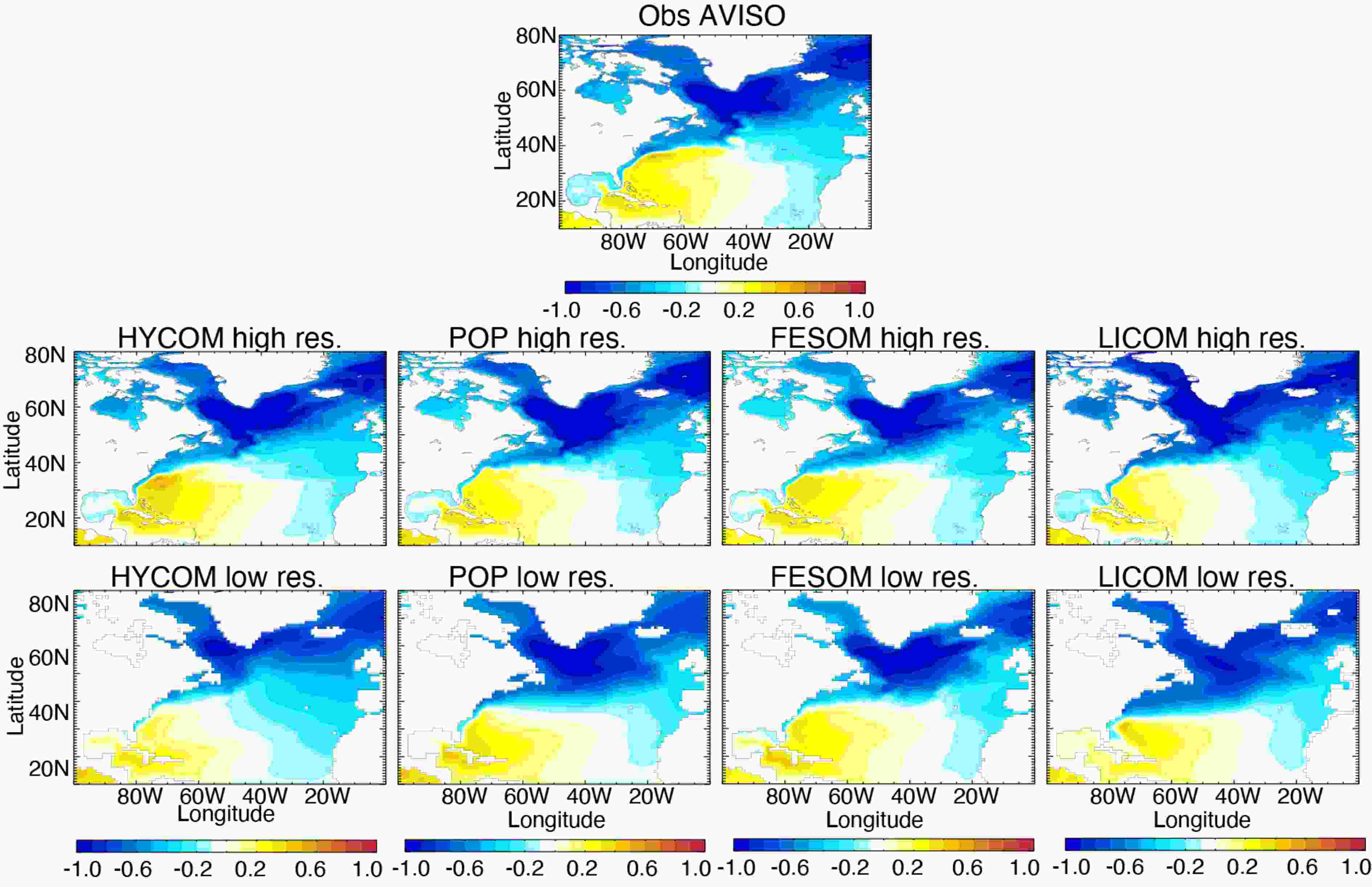 Figure1. Mean 1993–2018 SSH (units: m) fields for observations (Rio et al., 2014) (top panel), high-resolution experiments (middle panel), and low-resolution experiments (lower panel). [Reprinted from Chassignet et al. (2020b)].
Figure1. Mean 1993–2018 SSH (units: m) fields for observations (Rio et al., 2014) (top panel), high-resolution experiments (middle panel), and low-resolution experiments (lower panel). [Reprinted from Chassignet et al. (2020b)].As one would expect, the high-resolution experiments have much higher total kinetic energy than the low-resolution experiments (Chassignet et al., 2020a, b). In the high-resolution experiments, the range in globally averaged kinetic energy is between ~35 × 10?4 m2 s?2 (HYCOM) and ~15 × 10?4 m2 s?2 (LICOM). The fact that the kinetic energy is much higher in HYCOM may be due to the use of an absolute wind stress formulation in which the ocean current velocities are not taken into account. The other three models use relative winds in the wind stress formulation, which has an eddy-killing effect [see Renault et al. (2020) for a review] and can reduce the total kinetic energy by as much as 30%. The total kinetic energy in these high-resolution models is, however, still substantially lower than what can be estimated using observations and models (~50 × 10?4 m2 s?2) (Chassignet and Xu, 2017). The total kinetic energy increases by a factor of three to four when the resolution is increased in the models, but the variable grid spacing of FESOM does not resolve the Rossby radius of deformation uniformly and shows an increase by a factor of only two.
Associated with the higher kinetic energy is a substantial increase in SSH variability in the high-resolution experiments. This variability is much closer to what can be observed from altimetry (Fig. 2, top right panel). It is, however, still lower than observed, especially in the three experiments that use relative winds (POP, FESOM, and LICOM). There are many reasons why one should take into account the vertical shear between atmospheric winds and ocean currents when computing the wind stress; first and foremost, it is more physical. It also allows for a better representation of western boundary current systems (Renault et al., 2016, 2020). This is especially true for the Agulhas Current retroflection and associated eddies (Renault et al., 2017). When using absolute winds as in HYCOM, the Agulhas eddies shed too regularly from the Agulhas Current and follow a similar pathway into and across the South Atlantic. This is alleviated in the three simulations with relative winds, which have an Agulhas eddies pathway closer to what is observed and where the location of the Agulhas retroflection and eddy formation is more realistic.
 Figure2. Top panel: Mean 1993–2018 SSH (units: m) and variance of AVISO. Middle panel: Difference between the mean modeled SSH and AVISO SSH. Bottom panel: Modeled variance derived from five-day average outputs. The low-resolution LICOM SSH variance was not provided. [Reprinted from Chassignet et al. (2020a)].
Figure2. Top panel: Mean 1993–2018 SSH (units: m) and variance of AVISO. Middle panel: Difference between the mean modeled SSH and AVISO SSH. Bottom panel: Modeled variance derived from five-day average outputs. The low-resolution LICOM SSH variance was not provided. [Reprinted from Chassignet et al. (2020a)].From a climate perspective, researchers are especially interested in the time evolution of ocean heat content, sea level, and sea ice. The high-resolution models have a tendency to warm up more rapidly at depths below 700 m than the coarse-resolution models. Griffies et al. (2015) did find that vertical heat transport differs depending on if the eddies are parameterized (coarse-resolution) or resolved (high-resolution), and errors in eddy subgrid-scale parameterizations could, therefore, be responsible for this tendency. Overall, despite a significant improvement in the position, strength, and variability of western boundary currents, equatorial currents, and the Antarctic Circumpolar Current, there is no consistent improvement in temperature and salinity drift among the models when the horizontal resolution is increased. Some regions even display increased biases [see Chassignet et al. (2020a) for details]. In summary, an increase in horizontal resolution does not always deliver clear bias improvement everywhere for all models.
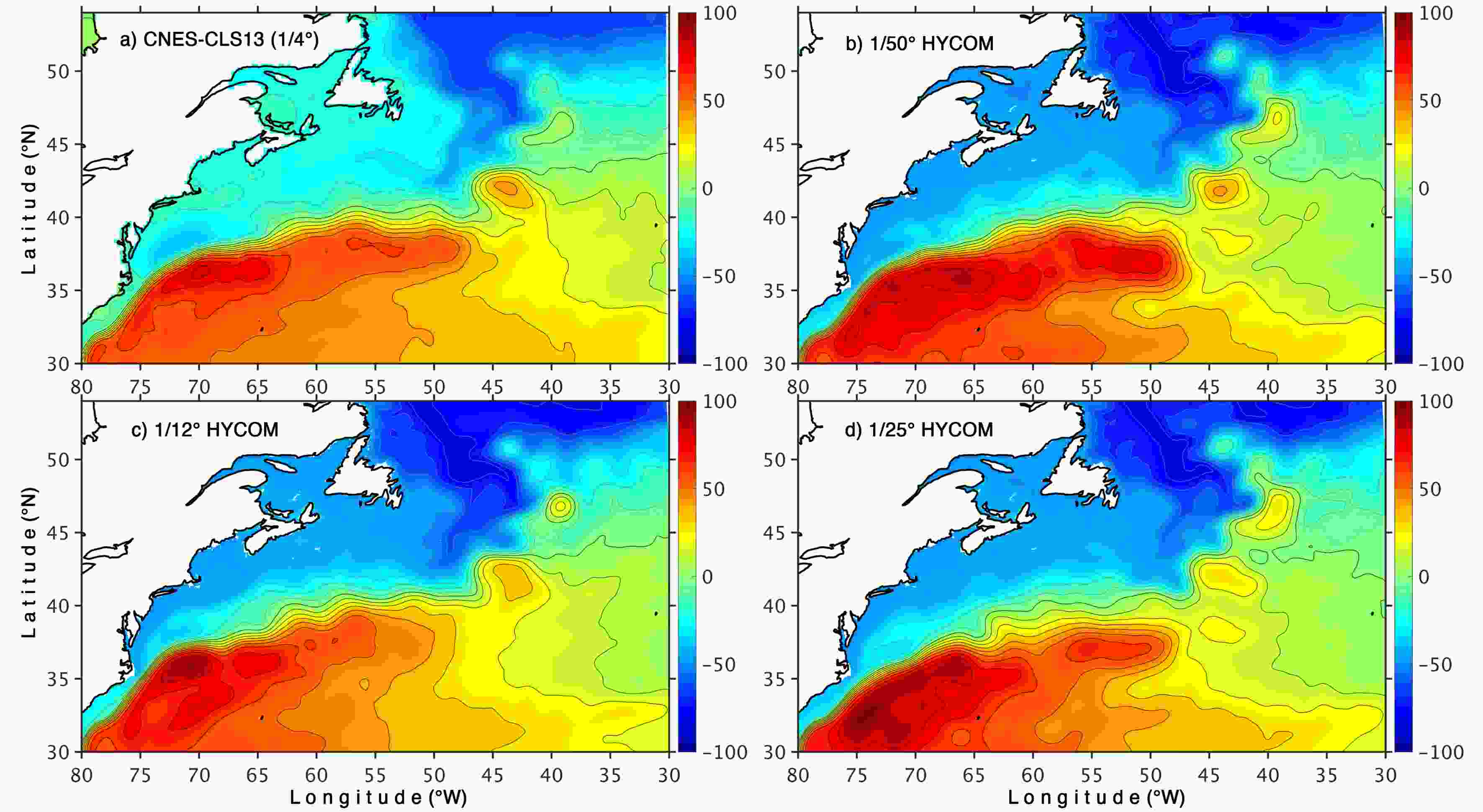 Figure3. Mean SSH (units: cm) in the Gulf Stream region: (a) 1993–2012 observed mean from Rio et al. (2014), (b) 1/50°, (c) 1/25°, and (d) 1/12° HYCOM (years 16–20). [Adapted from Chassignet and Xu (2017)]. In the three simulations, the Gulf Stream separates at Cape Hatteras, but the extent of its eastward interior penetration varies greatly. At 1/12° (Fig. 3c), the modeled Gulf Stream does not extend far into the interior and the SSH variability (Fig. 4c) is concentrated west of the New England seamounts (60°W). There is no visible improvement when the resolution is doubled to 1/25° (Fig. 3d) simulation – on the contrary, there is an unrealistically strong recirculating gyre southeast of Cape Hatteras with excessive surface variability (Fig. 4d). On the other hand, when the resolution is increased to 1/50° (Fig. 3b), the Gulf Stream penetration, recirculating gyre, and extension become very realistic and compare extremely well to the latest mean dynamic topography derived from observations (top left panel).
Figure3. Mean SSH (units: cm) in the Gulf Stream region: (a) 1993–2012 observed mean from Rio et al. (2014), (b) 1/50°, (c) 1/25°, and (d) 1/12° HYCOM (years 16–20). [Adapted from Chassignet and Xu (2017)]. In the three simulations, the Gulf Stream separates at Cape Hatteras, but the extent of its eastward interior penetration varies greatly. At 1/12° (Fig. 3c), the modeled Gulf Stream does not extend far into the interior and the SSH variability (Fig. 4c) is concentrated west of the New England seamounts (60°W). There is no visible improvement when the resolution is doubled to 1/25° (Fig. 3d) simulation – on the contrary, there is an unrealistically strong recirculating gyre southeast of Cape Hatteras with excessive surface variability (Fig. 4d). On the other hand, when the resolution is increased to 1/50° (Fig. 3b), the Gulf Stream penetration, recirculating gyre, and extension become very realistic and compare extremely well to the latest mean dynamic topography derived from observations (top left panel).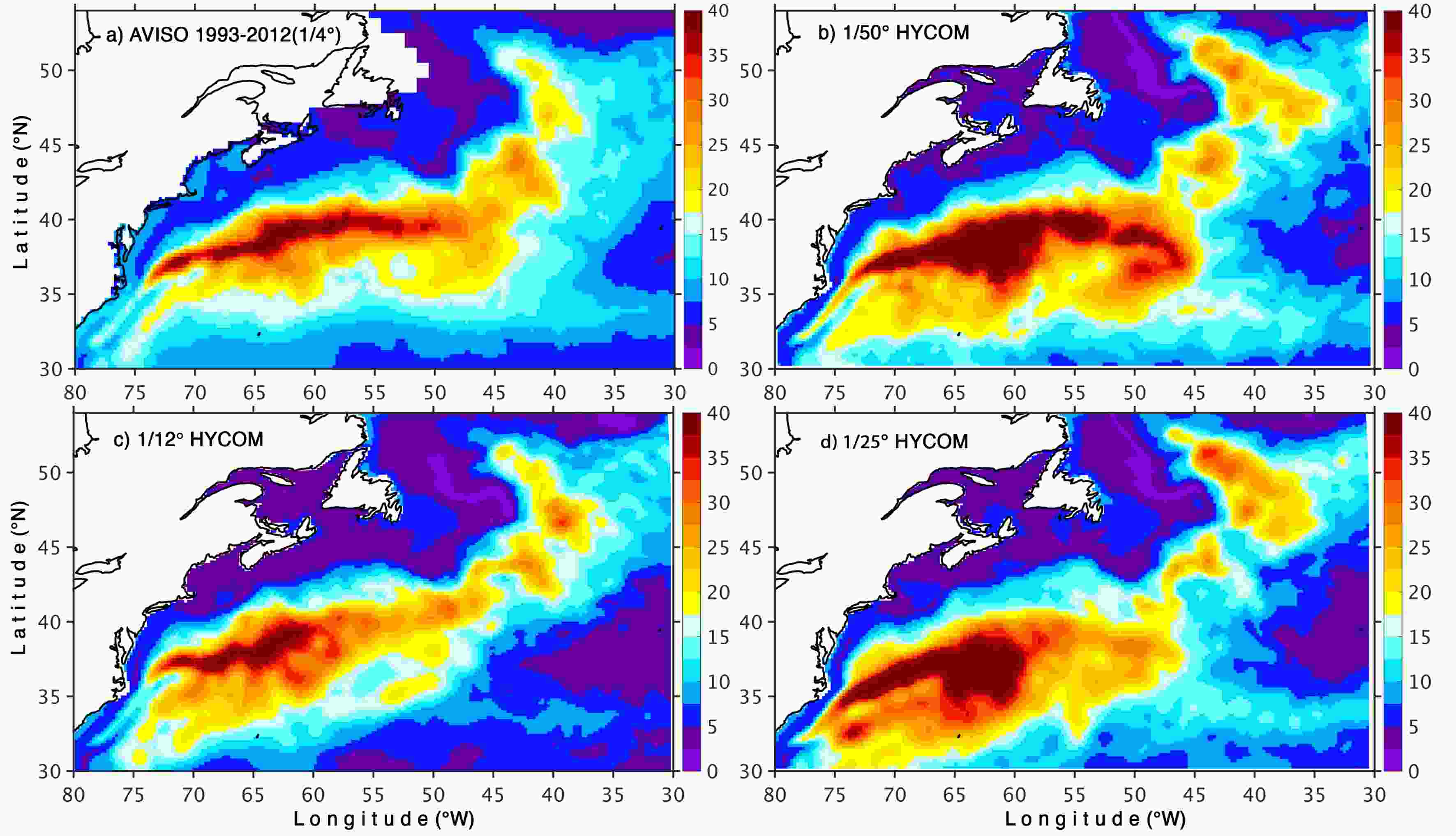 Figure4. SSH variability (units: cm) in the Gulf Stream region, (a) based on AVISO (1993–2012) and (b–d) the 1/50°, 1/25°, and 1/12° HYCOM simulations, respectively (years 16–20). The model outputs were filtered to be representative of the AVISO gridded outputs by subsampling of the model outputs to the AVISO 1/4° grid, time averaging the outputs over 10 days, and applying a 150 km band pass filter.
Figure4. SSH variability (units: cm) in the Gulf Stream region, (a) based on AVISO (1993–2012) and (b–d) the 1/50°, 1/25°, and 1/12° HYCOM simulations, respectively (years 16–20). The model outputs were filtered to be representative of the AVISO gridded outputs by subsampling of the model outputs to the AVISO 1/4° grid, time averaging the outputs over 10 days, and applying a 150 km band pass filter.2
4.1. Impact of bathymetry
The fact that the modeled high SSH variability is wider than observed near the New England seamounts chain in the 1/50° experiment (Fig. 4b) suggests that interactions with the topography may be overemphasized in that specific configuration. In this section, we will show that the bathymetry has a much more profound impact on the Gulf Stream pathway than one would have a priori anticipated. In Chassignet and Xu (2017), the goal was to perform a convergence study where most parameters are not changed as the grid spacing is refined from 1/12° to 1/50° and the bathymetry used for the 1/50° configuration (hereafter referred to as NEATL) was linearly interpolated from the coarser 1/12° topography based on the 2’ Naval Research Laboratory (NRL) digital bathymetry database, which combines the global topography based on satellite altimetry of Smith and Sandwell (1997) with several high-resolution regional databases. To investigate the impact of a higher-resolution bathymetry, the last five years of NEATL were repeated (hereafter experiment NEATL-HB) with a new bathymetry derived from the latest 15 arc-seconds GEBCO 2019 bathymetry, which contains significantly higher resolution topographic features (see detailed difference in bathymetry displayed in Fig. 7); all other parameters are identical to those of NEATL (see Chassignet and Xu (2017) for a detailed description).The five-year mean SSH for NEATL (coarse bathymetry) and NEATL-HB (fine bathymetry) are shown in Fig. 5 together with the latest observational estimate (Rio et al., 2014). Overall, both agree well with the observed mean (Fig. 5a), but there is a significant difference in the Gulf Stream mean pathway between the two simulations when the Gulf Stream crosses over the New England seamounts chain (area highlighted in the bottom two panels of Fig. 5). The SSH contours are much closer to each other and the Gulf Stream pathway is tighter in the high-resolution bathymetry experiment (NEATL-HB) than in the reference experiment (NEATL) with coarse linearly interpolated 1/12° bathymetry. The impact of the bathymetry is further illustrated by and is more striking in the plots of SSH variability for the last five years of both simulations (Fig. 6). Not only is the excess SSH variability near to the New England seamounts chain found in the experiment with coarse bathymetry (NEATL) gone, the shape of the variability and distribution of the variability in the experiment with high-resolution bathymetry is a very close match to the observations. This includes a deflection of the SSH variability to the north near 64°W when the Gulf Stream passes over the New England seamounts chain (see highlight in Figs. 5 and 6).
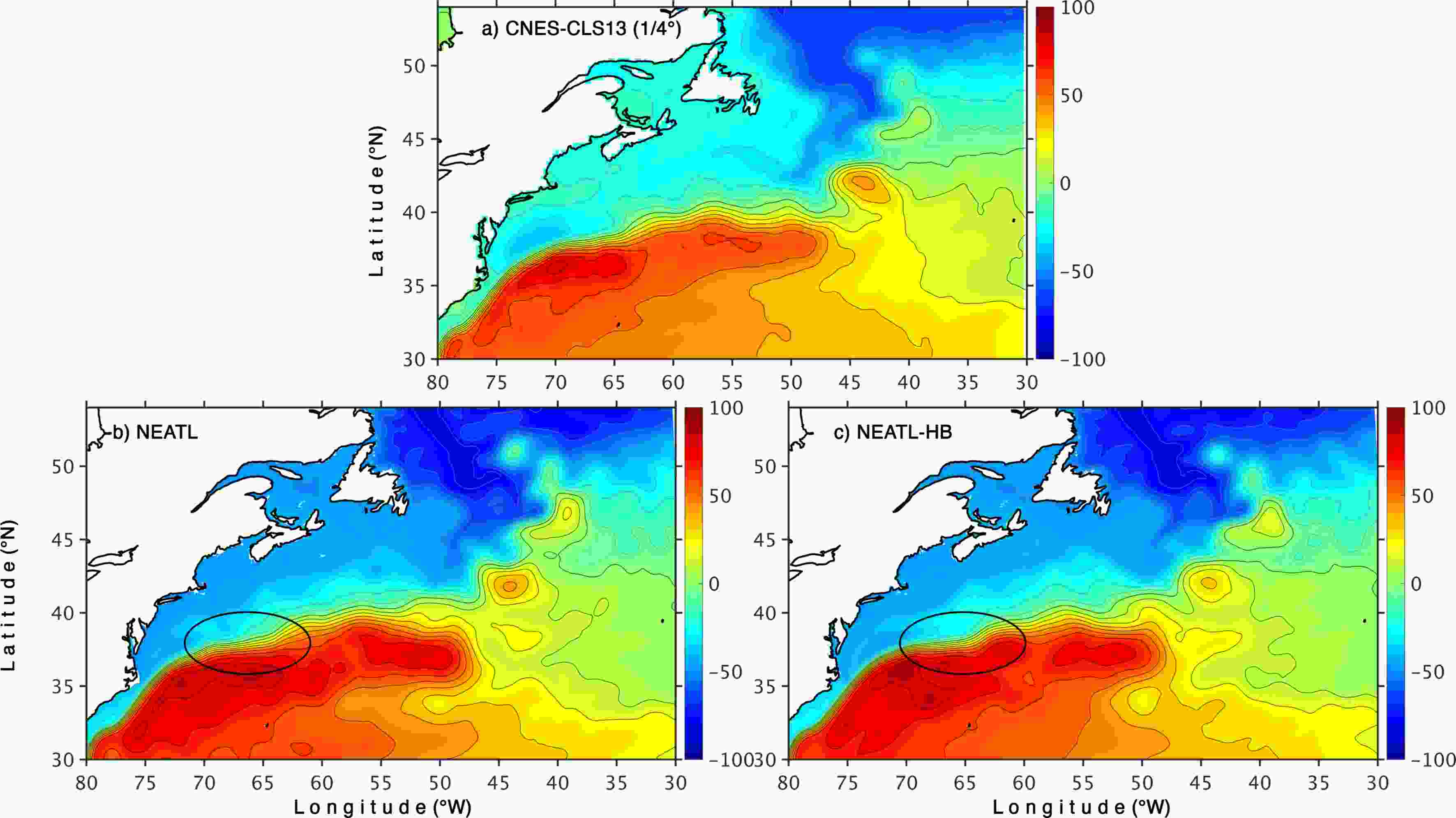 Figure5. Mean SSH (units: cm) in the Gulf Stream region for (a) 1993–2012 observed mean from
Figure5. Mean SSH (units: cm) in the Gulf Stream region for (a) 1993–2012 observed mean from 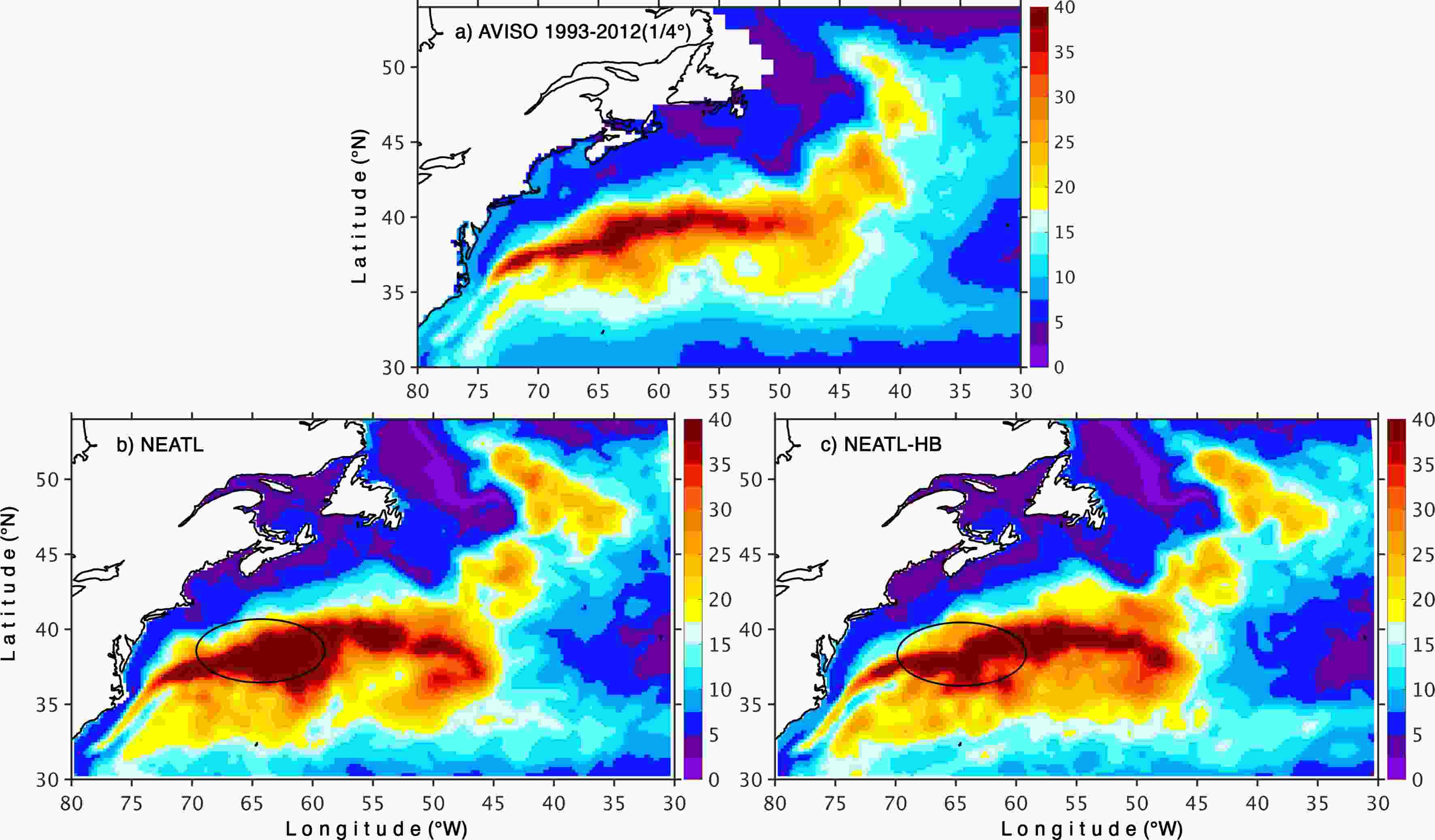 Figure6. SSH (units: cm) in the Gulf Stream region for (a) AVISO (1993–2012), (b) NEATL, and (c) NEATL-HB (years 16–20). The model outputs were filtered as in Fig. 4.
Figure6. SSH (units: cm) in the Gulf Stream region for (a) AVISO (1993–2012), (b) NEATL, and (c) NEATL-HB (years 16–20). The model outputs were filtered as in Fig. 4.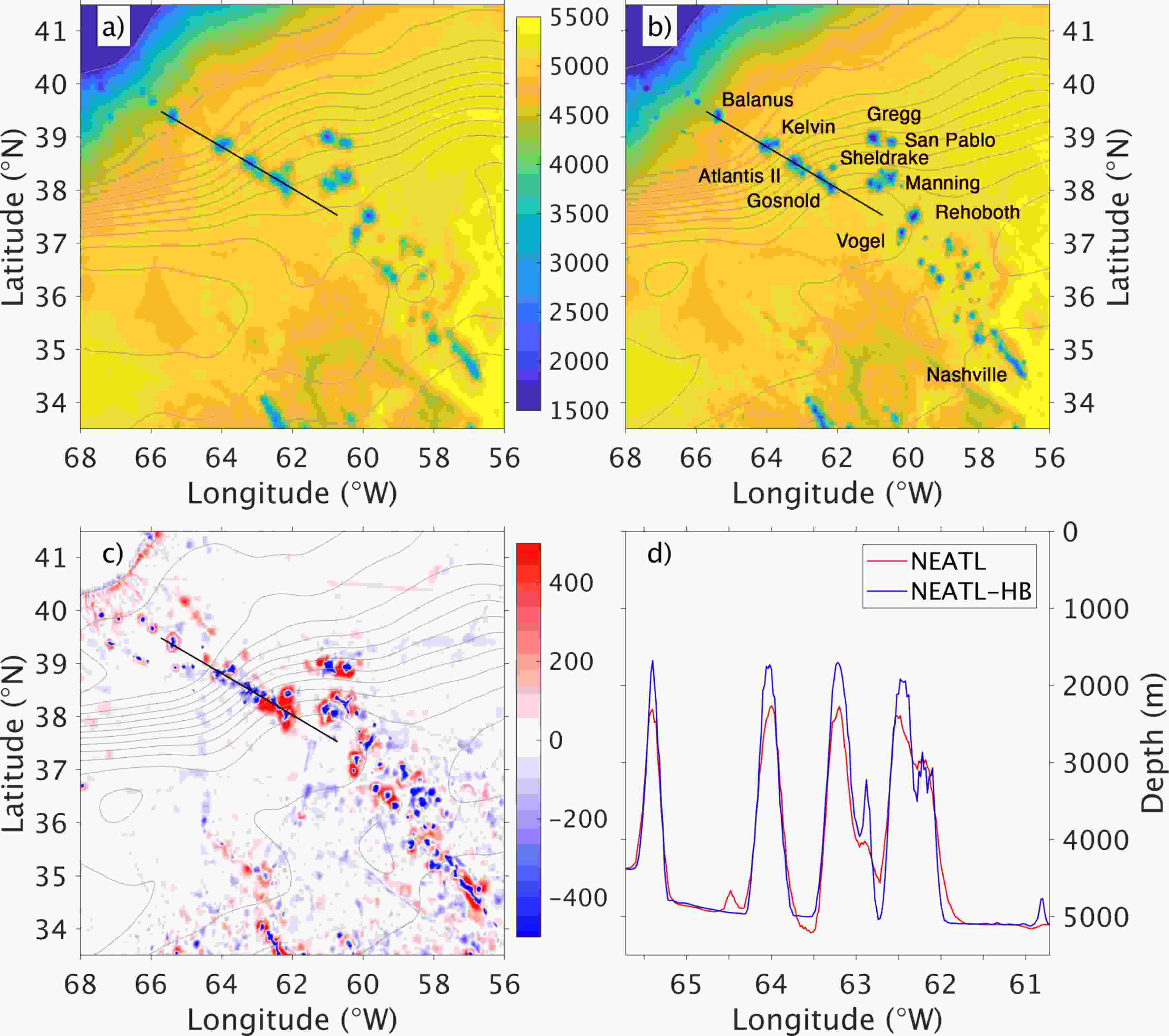 Figure7. (a) NEATL bathymetry in meters; (b) NEATL-HB bathymetry in meters with the names of the major seamounts (Houghton et al., 1977); (c) difference in bathymetry in meters between NEATL-HB and NEATL, blue color indicates a shallower depth in NEATL-HB and vice versa. The gray contours are the modeled five-year mean SSH in NEATL-HB indicating the mean Gulf Stream pathway; and (d) bathymetry along the central portion of the New England seamount chain (black line in left panel) that encounters the Gulf Stream direcly. The four seamounts from west to east are Balanus, Kelvin, Atlantis II, and Gosnold.
Figure7. (a) NEATL bathymetry in meters; (b) NEATL-HB bathymetry in meters with the names of the major seamounts (Houghton et al., 1977); (c) difference in bathymetry in meters between NEATL-HB and NEATL, blue color indicates a shallower depth in NEATL-HB and vice versa. The gray contours are the modeled five-year mean SSH in NEATL-HB indicating the mean Gulf Stream pathway; and (d) bathymetry along the central portion of the New England seamount chain (black line in left panel) that encounters the Gulf Stream direcly. The four seamounts from west to east are Balanus, Kelvin, Atlantis II, and Gosnold.The difference in bathymetry between the two experiments for the New England seamounts area is shown in Fig. 7c. In many respects, the differences are quite small (less than 100 m in most areas where the depth is close to 5000 m) with the biggest magnitude being around the seamounts. The bathymetry cross-section along the seamount chain (Fig. 7d) shows that the most striking difference is in the height of the seamounts (500 m higher in the water column), which are closer in NEATL-HB to the base of the permanent thermocline of 1000–1500 meters (Meinen and Luther, 2016). But the higher resolution bathymetry also better resolves the spatial extent of the New England seamounts (Figs. 7a and b), making them narrower and effectively increasing the separation distance between them, especially for the seamounts located between 62°W and 63.5°W (i.e., Atlantis II, Shelldrake, and Gosnold, Fig. 7b) and under the southern extent of the Gulf Stream. We interpret the difference in SSH variability between the two experiments, NEATL and NEATL-HB, as follows: In the coarse bathymetry experiment (NEATL), the three seamounts (Atlantis II, Shelldrake, and Gosnold) between 62°W and 63.5°W are not clearly separated from each other, and therefore, as discussed by Zhang and Boyer (1991), they can act as a single body and will appear as a large obstacle to the eastward flowing Gulf Stream. This in turn leads to larger meanders downstream of the seamounts via conservation of potential vorticity (Holton and Hakim, 2012) and consequently higher downstream eddy kinetic energy (Barthel et al., 2017). In the high-resolution bathymetry experiment, there is a larger separation distance between the seamounts, and the resulting flow field past the seamounts is determined by the interaction of the stream with relatively independent narrow obstacles, leading to less downstream variability (Zhang and Boyer, 1991). Thus, the instability processes induced by the Gulf Stream interacting with the New England seamounts are significantly diminished with better resolved topographic features and isolated seamounts. The reduced instabilities lead to a tighter Gulf Stream mean path that agrees better with the observed path and a narrower extent of high surface eddy kinetic energy that is in excellent agreement with the observations.
2
4.2. Impact of tides on the SSH wavenumber spectra
SSH wavenumber spectra are commonly used in the literature to quantify the energy and variability associated with different temporal and spatial scales. In the reference experiment (NEATL), the slope of the surface power spectra in the 70–250 km mesoscale range is mostly independent of latitude and ranges between –5 and –4 (Fig. 8b); it is only slightly flattened near the equator and in the northern North Atlantic near 60°N. However, altimeter observations (Fig. 8a) show large spatial latitudinal variability in the distribution of the SSH wavenumber spectra with steep slopes closer to –5 at midlatitudes and flattened slopes near –1 in the tropics (Xu and Fu, 2011, 2012; Zhou et al., 2015; Dufau et al., 2016). A lack of latitudinal dependence in the 70–250 km band with slopes between –5 and –4 was also found in previous modeling studies (Paiva et al., 1999; Richman et al., 2012, Sasaki and Klein, 2012; Biri et al., 2016), and several explanations have been put forward to explain the differences with the altimeter observations. This includes aliasing and noise in the altimetry data (Biri et al., 2016) and underestimation of the impact of high frequency motions (i.e., internal waves and tides) when using daily averages to compute the wavenumber spectra (Richman et al., 2012; Rocha et al., 2016; Tchilibou et al., 2018). Previous studies (Rocha et al., 2016; Tchilibou et al., 2018) have shown that internal tides can have a significant impact on the wavenumber spectra, especially on small scales. Therefore, we further investigated the latitudinal dependence of the SSH power spectra on high-frequency motions by adding tidal forcing to the 1/50° North and Equatorial Atlantic HYCOM simulation in the last 1.5 years of NEATL (hereafter referred to as NEATL-T-HB). In NEATL-T-HB, eight tidal constituents (M2, S2, O1, K1, N2, P1, K2, and Q1) are added via body and lateral boundary forcing. At the northern and southern boundaries, the phase and amplitude are specified using the TPXO8-atlas global tidal solutions from Oregon State University. All other parameters are identical to that of NEATL (see Chassignet and Xu (2017) for a detailed description).Figure 8 shows the slope of the SSH wavenumber spectra in the 70–250 km mesoscale range in 10° × 10° boxes over the North Atlantic domain from both NEATL and NEATL-T-HB. The latitudinal dependence is drastically different in NEATL-T-HB from that of the reference experiment with slopes that are close to –1 in the tropics as in the observations (Fig. 8a). This is due to tidal forcing and the generation of internal tides since the addition of high-resolution bathymetry alone was found to have only a very small impact on the slope of SSH power spectra in the 70–250 km mesoscale range (sensitivity experiment not shown). The tidal forcing in NEATL-T-HB generates internal tides that have a strong SSH signature (Fig. 9, bottom panel) that is not present in the absence of tidal forcing (Fig. 9, top panel). These internal tides are generated in areas of strong topography around the Azores, the Cape Verde islands, off the North Brazil coast near the Amazon estuary, as well on the northern side of the Georges Bank past the New England seamounts. The surface signal associated with the internal tides significantly modifies the power spectra in the equatorial region (Fig. 10) with two peaks, one in the 110–130 km range and another one at near 70 km, which flatten the slope in the equatorial region (Fig. 8c). This leads to a modeled spectral slope in the equatorial region that is in excellent agreement with the filtered observational estimate of Zhou et al. (2015) (Figs. 8 and 10). The impact of the internal tides on the power spectra is not as large in the midlatitudes (Fig. 8) because the magnitude of the SSH variability is lower in the equatorial region than in the midlatitudes [see Fig. 26 of Chassignet and Xu (2017) for details].
 Figure9. Root-mean-square (RMS) of the high-frequency steric SSH variability (units: cm) for (a) NEATL and (b) NEATL-T-HB. The RMS is calculated daily from 24 hourly snapshots of the steric SSH and is averaged over a month (December) – the results do not change if a longer time average is used.
Figure9. Root-mean-square (RMS) of the high-frequency steric SSH variability (units: cm) for (a) NEATL and (b) NEATL-T-HB. The RMS is calculated daily from 24 hourly snapshots of the steric SSH and is averaged over a month (December) – the results do not change if a longer time average is used. Figure8. Slope of the SSH power spectra in the 70–250 km mesoscale range in 10° × 10° boxes: (a) observational estimate of Zhou et al. (2015); (b) NEATL, and (c) NEATL-T-HB. Note that the sign of the slope was reversed.
Figure8. Slope of the SSH power spectra in the 70–250 km mesoscale range in 10° × 10° boxes: (a) observational estimate of Zhou et al. (2015); (b) NEATL, and (c) NEATL-T-HB. Note that the sign of the slope was reversed.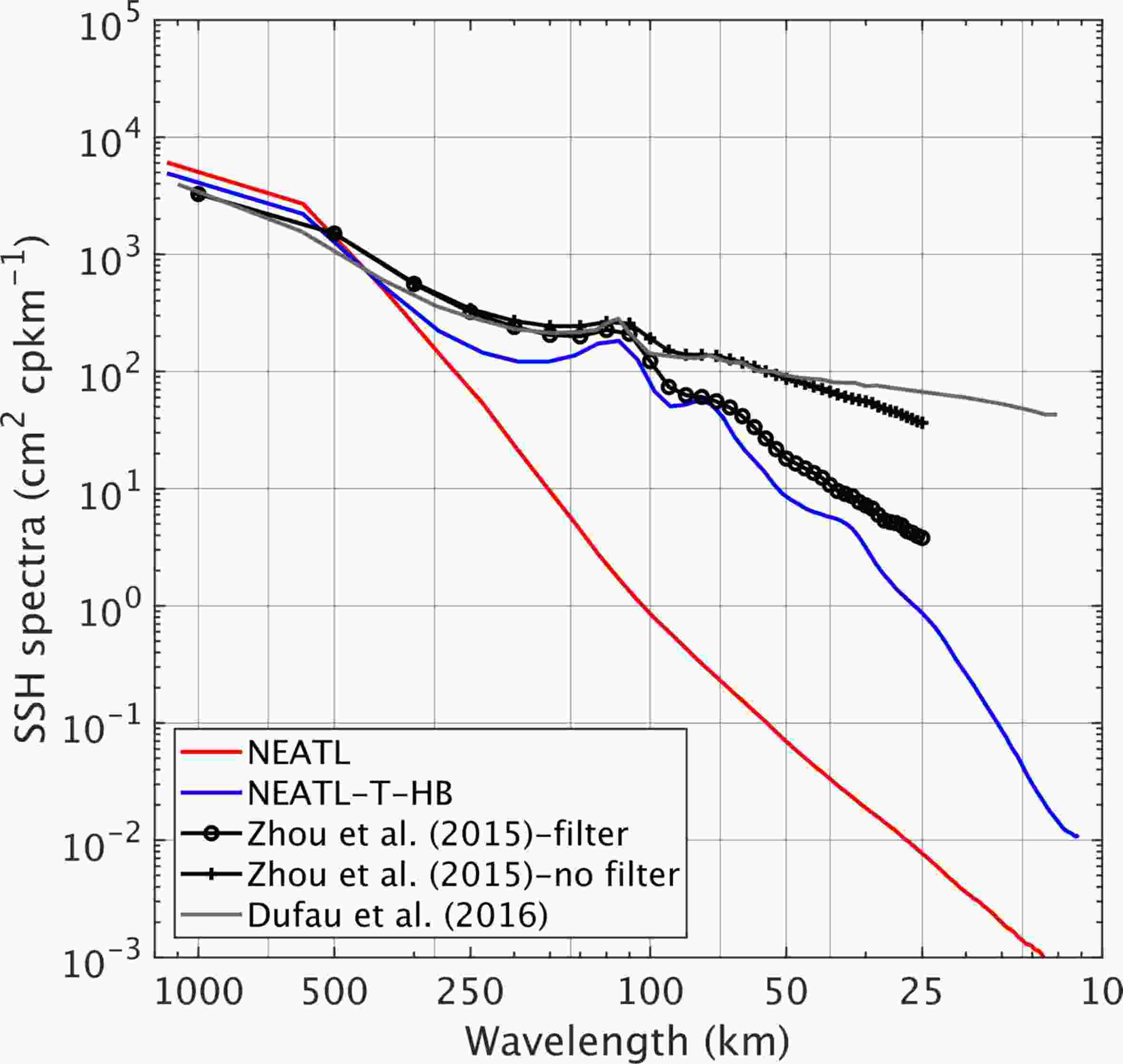 Figure10. SSH power spectra calculated along altimeter tracks and computed as a four 10° × 10° boxes average across the equator (35°–15°W, 10°S–10°N). Red and blue lines are results for year 20 of NEATL and NEATL-T-HB; the black lines are observations (unfiltered and filtered for noise) (Zhou et al. 2015); and the gray line are unfiltered observations (Dufau et al. 2016).
Figure10. SSH power spectra calculated along altimeter tracks and computed as a four 10° × 10° boxes average across the equator (35°–15°W, 10°S–10°N). Red and blue lines are results for year 20 of NEATL and NEATL-T-HB; the black lines are observations (unfiltered and filtered for noise) (Zhou et al. 2015); and the gray line are unfiltered observations (Dufau et al. 2016).The considerable differences in surface EKE in the global high-resolution models of Chassignet et al. (2020a) were associated with the use of relative winds versus absolute winds. Chassignet and Xu (2017) showed that the level of EKE in the 1/50° simulation was comparable to the observations when one takes into account the aliasing associated with the altimeter sampling. However, this was obtained by using absolute wind stresses at the ocean surface which do not allow any oceanic feedback to the atmosphere via SST (Small et al., 2008; Ma et al., 2016) or ocean current/wind shear (Renault et al., 2020). The use of relative winds in the wind stress can lead to a significant reduction of the surface EKE (on the order of 30%; Renault et al., 2020). This implies that the next generation of numerical simulations will need to either further increase the horizontal resolution or use less dissipative numerical operators in order be able to reach a level of EKE comparable to observations when using relative winds. In addition, the bulk formulae used in this class of models do not take into account any partial re-energization of the ocean by a changing atmosphere. A parameterization of this effect was recently proposed by Renault et al. (2020), but another approach, short of coupling the ocean model to an active atmosphere (HighResMIP, Haarsma et al., 2016), is to use an intermediate complexity marine atmospheric boundary layer model as in Lemarié et al. (2020) to represent the key processes associated with air–sea interactions on characteristic oceanic scales in the ocean-only numerical simulations.
The computational cost of simulations at 1/50° is extremely large, and while currently available computer resources do not allow for decadal global simulations at that resolution, we will soon have the ability to do so in the future. Ocean/climate modelers are one of the biggest groups of users of computer resources, and as resolution is further refined, they will always require the latest generation of supercomputers. This means that further progress will only take place when the numerical codes used in ocean models take full advantage of the latest computing architecture, and this implies close collaborations with computer scientists. Presently, supercomputer development is closely linked to the performance of commodity chips (i.e., GPUs), and because of their reduced memory access, these are not well-adapted to ocean applications. The main limitation is, therefore, not just the computational speed of the processors but also, as stated by Le Sommer et al. (2018), access to memory and latency in reading/writing on disk drives (see Wang et al. (2020) for an application of a GPU-based version of LICOM3).
Acknowledgements. EPC would like to thank Dr. Hailong LIU and his colleagues for their warm welcome during EPC’s visit in summer 2019 to the State Key Laboratory of Numerical Modeling for Atmospheric Sciences and Geophysical Fluid Dynamics, Institute of Atmospheric Physics, Chinese Academy of Sciences, Beijing, China. Support for this visit was made possible by the Chinese Academy of Sciences (CAS) President's International Fellowship Initiative (PIFI). This overview article is heavily influenced by and reiterates many of the key points found in articles, chapters, and review papers written by the authors. Appropriate references were made, but there are many similarities in content and style to these publications throughout this article.
Open Access This article is distributed under the terms of the Creative Commons Attribution 4.0 International License (
